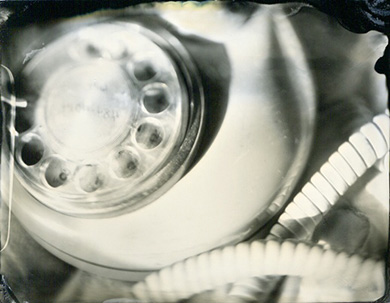


Calling China was preceded historically both by Digging to China and by Riki Tiki Tembo, but not necessarily in that order. There were always regional differences. In its proper execution, Calling China resembled an act of faith or folly, depending on the vantage point from which one viewed it. As it happened, Calling China became popular in the years leading up to the events at Tiananmen Square (1989) and, shortly thereafter, its popularity ended.
In those times all one needed for Calling China was an unmonitored rotary telephone—preferably the color of pantyhose—and at least twenty random digits. Today’s touchtone cellular devices offer many conveniences and popular entertainments, but as a means to this particular end they are ill-fit. Calling China requires a machine with gravitas, an instrument capable of housing the inner workings necessary to corroborate and intensify the natural and physical forces of the world. As such, the rotary phone was always mounted at a tantalizing height on a load-bearing wall.
A securely mounted telephonic machine provided the much needed backbone for Calling China. At the base of all great acts is a sturdy foothold. When Calling China, a kitchen chair would be positioned adjacent to the wall on which the machine was anchored. Here the child climbed to his position and, after taking the shoe-like receiver off the hook, he would dial with notable athleticism. Of the many pitfalls to be avoided when Calling China, the most disastrous to the caller’s success was his own half-heartedness. A steely constitution was mandatory, as well as the understanding that the speed and the depth of his dialing corresponded to the distance his call would travel. Many who set out Calling China lost their resolve in the dizzying rhythm of the rotary, and failing to reach the requisite digits, ended up Calling East Peoria.
In its popular form, the practice of Calling China crystallized during the drought of 1987, when day after day hummed with heat and the great lawns burned in the obsolescence of rain. Doubt plagued the people and, teeming in their rearward minds, the locusts gathered and stirred up a biblical dust. The callers themselves had been driven into the clinical, cool realms where the air-conditioning whirled hypnotically, driving out the heat from their parents’ homes and creating, if you will, a sort of indoor/outdoor Yin-Yang. Demographically speaking, this group of non-descript and unsupervised Midwestern children were responsible for pushing the form to the peak of its popularity.
It is true that the seeds of Calling China were watered by unsupervised boredom, but this circumstance also accounts for the bizarre behaviors that led up to the great leap itself. Prior to Calling China, there were outdoor flights into madness, the deformed logic of summer in its nascent stage evident in the ritualistic burning of action figures, and later, in the repeated egging of the neighbor’s house, this vandalism sometimes amplified by nudity. If in these exhibitions there was an expression of anything, it was of a ragged humanity, its relentless desire to transform the lamentable world. It was this world—not of mythical proportions, but of mysteries as common as fire, food, and body—where these children dabbled in the power of the transformative. Though they could not name or trace it, some folly was clearly at work cooking up a world in which they could not help but appear.

